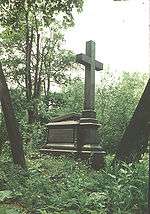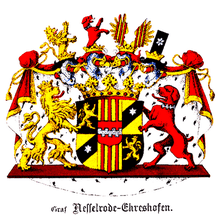Karl Nesselrode
Karl Robert Reichsgraf[2] von Nesselrode-Ehreshoven, also known as Charles de Nesselrode, (Lisbon, Portugal, 14 December 1780 – Saint Petersburg, 23 March 1862; Russian: Карл Васильевич Нессельроде, Karl Vasilyevich Nesselrode) was a Russian German diplomat. His mother was Louise Gontard (1746-1785), whose family belonged to Huguenot noble families from Dauphiné that fled from France to Germany in 1700. For forty years (1816-1856) Nesselrode as foreign minister guided Russian policy; he was a leading European conservative statesman of the Holy Alliance.

Biography
Karl von Nesselrode was born at sea[3][4] near Lisbon, Portugal into the Uradel Nesselrode family which originated in the Bergisches Land. His father Count Wilhelm Karl von Nesselrode (1724 - 1810), a count of the Holy Roman Empire, served at the time as the ambassador of the Russian Empress to Portugal. In deference to his mother's Protestantism he was baptized in the chapel of the British Embassy, thus becoming a member of the Church of England.[5] After his father became the Russian ambassador to the Prussian court about 1787, Nesselrode's education in a Berlin gymnasium re-inforced his Germanic roots. Even though Nesselrode would work for the Russians for the next few decades of his life, he could neither read nor write Russian and spoke it only brokenly.
In 1788, at the age of 8, he officially entered the Russian Navy. With his father's influence, he secured the position of naval aide-de-camp to Emperor Paul (r. 1796–1801).
He then transferred to the army, and entered diplomatic service under Paul I's son and successor, Emperor Alexander I. He was attached to the Russian embassy at Berlin, and transferred thence to the Hague.
In August 1806 Nesselrode received a commission to travel in southern Germany to report on the French troops there; he was then attached as diplomatic secretary to Generals Kamenski, Buxhoewden and Bennigsen in succession.
He was present at the inconclusive Battle of Eylau in January 1807, fought by Count von Bennigsen, and assisted at the negotiations of the Peace of Tilsit (July 1807), which Spanish Bonapartist Diego Fernandez de Velasco, 13th Duke of Frías (who in 1811 would die in exile in Paris), congratulated and was seated at table with Napoleon I.
Following the Congress of Erfurt in 1808, Nesselrode was secretly accredited by Alexander to serve as his unofficial channel of information between himself and Talleyrand.

Nesselrode became State Secretary in 1814 and was the head of Russia's official delegation to the Congress of Vienna, but for the most part Alexander I acted as his own foreign minister. In 1816, Nesselrode became Russian foreign minister, sharing influence with Count Ioannis Kapodistrias until the latter's retirement in 1822.
For forty years, Nesselrode guided Russian policy and was a leading European conservative statesman of the Holy Alliance. He was a key contributor in the construction of the peaceable congress system after the Napoleonic Wars. Between 1845 and 1856, he served as Chancellor of the Russian Empire. As Minister of Foreign Affairs in 1824, he was a plenipotentiary during negotiations with the United States in defining the boundary between Russian America and the American claims known as the Oregon Country, which were resolved with the Russo-American Treaty of 1824, and a parallel treaty with Britain concerning British claims which overlapped with those of the U.S. A century later in 1924, Mount Nesselrode in the Boundary Ranges of the Alaska-British Columbia boundary was named for him.[6]
In 1849 Nesselrode sent Russian troops to aid Austria in putting down the Hungarian revolution led by Lajos Kossuth.
One frequently-overlooked facet of Nesselrode's activity involved his attempts to penetrate Japan's self-isolation. In 1853 he dispatched Yevfimiy Putyatin with a letter to the shōgun; Putyatin returned to St. Petersburg with the favorable Treaty of Shimoda (signed 1855).
Nesselrode's efforts to expand Russia's influence in the Balkans and Mediterranean led to conflicts with Turkey, Britain, the then Kingdom of Sardinia, the then Duchy of Savoy and France, which all became allies opposing Russia in the Crimean War (1853–1856). Britain and France, unhappy with Russia's growing influence, determined to support Turkey and so restrict Russia.
Nesselrode's autobiography was published posthumously in 1866.
Honours
- Knight of the Order of Saint Alexander Nevsky.[7]
- Knight grand Cross of the Order of Saint Vladimir.[8]
- Knight of the Order of the Elephant.[9]
- Knight grand Cross of the Order of the Polar Star.[10]
- Knight grand Cross of the Order of the Crown.[11]
- Knight grand Cross of the Royal Guelphic Order.[12]
- Knight grand Cross of the House Order of Fidelity.[13]
- Knight of the Order of the White Eagle.[14]
- Knight grand Cross of the Order of Saint Stephen of Hungary.[15]
- Knight grand Cross of the Order of the Holy Ghost.[16]
- Knight grand Cross of the Order of Saint Michael.[17]
- Knight grand Cross of the Order of the Black Eagle.[18]
- Knight grand Cross of the Order of the Red Eagle.[19]
- Knight grand Cross of the Supreme Order of the Most Holy Annunciation.[20]
- Knight grand Cross of the Order of Charles III.[21]
- Knight grand Cross of the Order of Saint Ferdinand and of Merit.[22]
- Grand Cross in the Legion of Honour.[23]
Cuisine legacy
Foods named in his honour but devised by his chef M. Jean Mouy[24] using chestnut puree[25] are-
- Nesselrode Pudding (Pouding à la Nesselrode), a thick custard cream with sweet puree of chestnut, raisins, candied fruit, currants, cherry liquor and whipped cream molded and served chilled as a bombe with maraschino custard sauce[26].
- Nesselrode Pie, a chestnut custard cream pie
References
- Klingspor 1882, p. 77.
- Regarding personal names: Reichsgraf is a title, usually translated as Imperial Count, not a first or middle name. The female form is Reichsgräfin. Titles using the prefix Reichs- were not created after the fall of the Holy Roman Empire.
- Appletons' annual cyclopaedia and register of important events of the year: 1862. New York: D. Appleton & Company. 1863. p. 641.
NESSELRODE, Count Karl Robert von, a Russian statesman, born on board of a Russian frigate in the harbor of Lisbon, Dec. 14, 1770 [...].
-
Golovin, Ivan Gavrilovich (1854). "Menshikoff, Orloff, Nesselrode". The Nations of Russia and Turkey and Their Destiny. London: Trübner. p. 149. Retrieved 21 Mar 2019.
Charles Albert, Count Nesselrode, was born in 1770, on board an English vessel in sight of Lisbon.
-
Compare:
Golovin, Ivan Gavrilovich (1854). "Menshikoff, Orloff, Nesselrode". The Nations of Russia and Turkey and Their Destiny. London: Trübner. p. 149. Retrieved 21 Mar 2019.
His parents were Germans in the Russian service, and as there was no Protestant minister in the vessel, he was baptized according to the Anglican rite. England therefore, may claim the honour of reckoning him among her citizens.
- "Nesselrode, Mount". BC Geographical Names.
- 1824/diploamtic Code /treaty with russia in: Diplomatic Code of the United States of America: Embracing a Collection of ... Door Jonathan Elliot
- 1824/diploamtic Code /treaty with russia in: Diplomatic Code of the United States of America: Embracing a Collection of ... Door Jonathan Elliot
- 1824/diploamtic Code /treaty with russia in: Diplomatic Code of the United States of America: Embracing a Collection of ... Door Jonathan Elliot
- 1824/diploamtic Code /treaty with russia in: Diplomatic Code of the United States of America: Embracing a Collection of ... Door Jonathan Elliot
- 1824/diploamtic Code /treaty with russia in: Diplomatic Code of the United States of America: Embracing a Collection of ... Door Jonathan Elliot
- 1824/diploamtic Code /treaty with russia in: Diplomatic Code of the United States of America: Embracing a Collection of ... Door Jonathan Elliot
- 1824/diploamtic Code /treaty with russia in: Diplomatic Code of the United States of America: Embracing a Collection of ... Door Jonathan Elliot
- 1824/diploamtic Code /treaty with russia in: Diplomatic Code of the United States of America: Embracing a Collection of ... Door Jonathan Elliot
- 1824/diploamtic Code /treaty with russia in: Diplomatic Code of the United States of America: Embracing a Collection of ... Door Jonathan Elliot
- 1824/diploamtic Code /treaty with russia in: Diplomatic Code of the United States of America: Embracing a Collection of ... Door Jonathan Elliot
- 1824/diploamtic Code /treaty with russia in: Diplomatic Code of the United States of America: Embracing a Collection of ... Door Jonathan Elliot
- 1824/diploamtic Code /treaty with russia in: Diplomatic Code of the United States of America: Embracing a Collection of ... Door Jonathan Elliot
- 1824/diploamtic Code /treaty with russia in: Diplomatic Code of the United States of America: Embracing a Collection of ... Door Jonathan Elliot
- 1824/diploamtic Code /treaty with russia in: Diplomatic Code of the United States of America: Embracing a Collection of ... Door Jonathan Elliot
- 1824/diploamtic Code /treaty with russia in: Diplomatic Code of the United States of America: Embracing a Collection of ... Door Jonathan Elliot
- 1824/diploamtic Code /treaty with russia in: Diplomatic Code of the United States of America: Embracing a Collection of ... Door Jonathan Elliot
- 1824/diploamtic Code /treaty with russia in: Diplomatic Code of the United States of America: Embracing a Collection of ... Door Jonathan Elliot
- p.76 Loohuizen, Ria On Chestnuts: The Trees and Their Seeds Prospect, 2006
- https://www.nytimes.com/1988/12/07/garden/de-gustibus-the-culinary-mystery-of-nesselrode-pie.html
- p. 128 The Oxford Companion to Sugar and Sweets Oxford University Press, 1 Apr 2015

Further reading
- Cowles, Loyal. "The Failure to Restrain Russia: Canning, Nesselrode, and the Greek Question, 1825–1827." International History Review 12.4 (1990): 688-720.
- Grimsted, Patricia Kennedy. The foreign ministers of Alexander I: political attitudes and the conduct of Russian diplomacy, 1801-1825 (University of California Press, 1969)
- Ingle, Harold N. Nesselrode and the Russian rapprochement with Britain, 1836-1844 (University of California Press, 1976)
- Jelavich, Barbara. St. Petersburg and Moscow: Tsarist and Soviet Foreign Policy, 1814-1974 (1974)
- Schroeder, Paul W. The transformation of European politics, 1763-1848 (Oxford: Clarendon Press, 1994)
| Preceded by Nikolay Petrovich Rumyantsev |
Foreign Minister of Russia 1814–1856 with Ioannis Kapodistrias (1816–1822) |
Succeeded by Aleksandr Mikhailovich Gorchakov |
